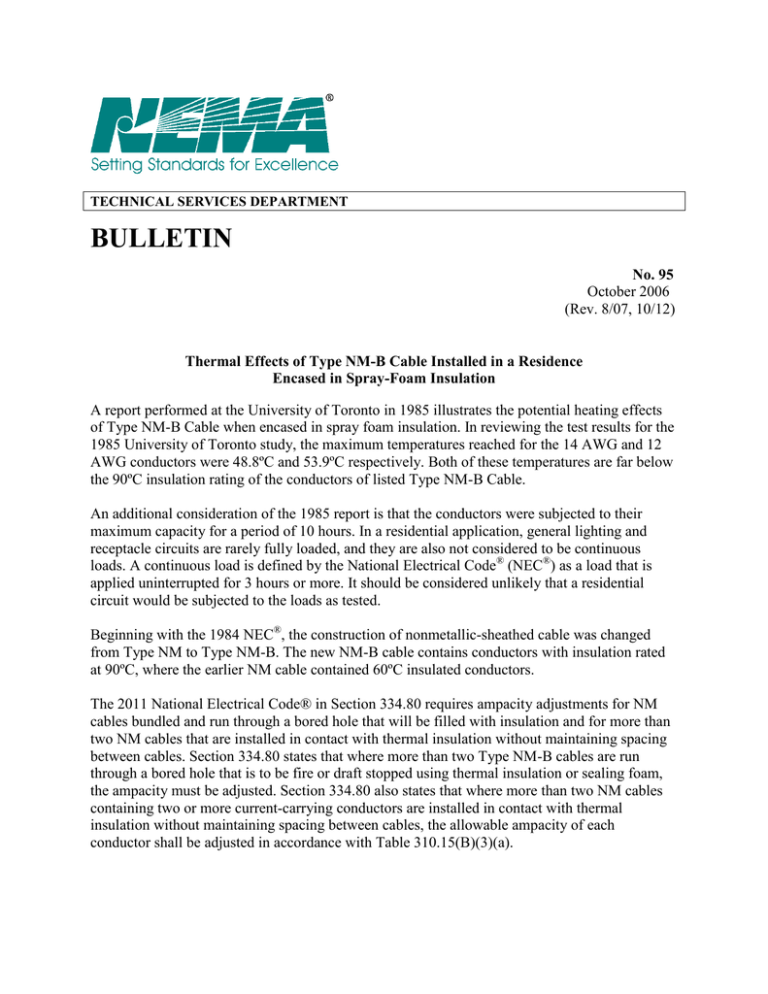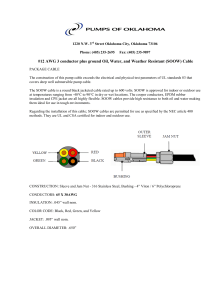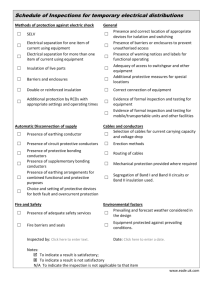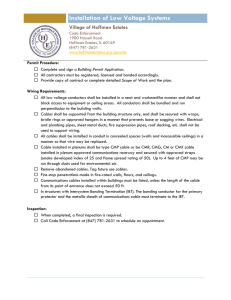bulletin
advertisement

TECHNICAL SERVICES DEPARTMENT BULLETIN No. 95 October 2006 (Rev. 8/07, 10/12) Thermal Effects of Type NM-B Cable Installed in a Residence Encased in Spray-Foam Insulation A report performed at the University of Toronto in 1985 illustrates the potential heating effects of Type NM-B Cable when encased in spray foam insulation. In reviewing the test results for the 1985 University of Toronto study, the maximum temperatures reached for the 14 AWG and 12 AWG conductors were 48.8ºC and 53.9ºC respectively. Both of these temperatures are far below the 90ºC insulation rating of the conductors of listed Type NM-B Cable. An additional consideration of the 1985 report is that the conductors were subjected to their maximum capacity for a period of 10 hours. In a residential application, general lighting and receptacle circuits are rarely fully loaded, and they are also not considered to be continuous loads. A continuous load is defined by the National Electrical Code® (NEC®) as a load that is applied uninterrupted for 3 hours or more. It should be considered unlikely that a residential circuit would be subjected to the loads as tested. Beginning with the 1984 NEC®, the construction of nonmetallic-sheathed cable was changed from Type NM to Type NM-B. The new NM-B cable contains conductors with insulation rated at 90ºC, where the earlier NM cable contained 60ºC insulated conductors. The 2011 National Electrical Code® in Section 334.80 requires ampacity adjustments for NM cables bundled and run through a bored hole that will be filled with insulation and for more than two NM cables that are installed in contact with thermal insulation without maintaining spacing between cables. Section 334.80 states that where more than two Type NM-B cables are run through a bored hole that is to be fire or draft stopped using thermal insulation or sealing foam, the ampacity must be adjusted. Section 334.80 also states that where more than two NM cables containing two or more current-carrying conductors are installed in contact with thermal insulation without maintaining spacing between cables, the allowable ampacity of each conductor shall be adjusted in accordance with Table 310.15(B)(3)(a). Type NM-B cable is installed in walls, ceilings, and floors with other types of insulation and the properties of the spray foam insulation are not different to warrant special consideration. Modular construction is a common method of building in which sectional walls are factory assembled of an outer and inner finished section with foam insulation between the finishes in which cables and and/or conductors are installed. This factory assembly is not significantly different from the on-site construction for the purposes of heat dissipation of the conductors. There are no reported problems with this type of construction and wiring. All common wiring methods utilize conductors with 90ºC insulation. These conductors, whether installed within a nonmetallic sheath, a metallic sheath or a raceway will generate the same amount of heat for a given load. The ability of those conductors to dissipate that heat when encased within insulation will likely be very similar, regardless of the wiring method. If the combination of temperature rise and heat dissipation is a concern, it should be a concern regardless of the wiring method. In summary: The National Electrical Code® does not prohibit installing Type NM-B cable in spray foam insulation. The NEC® contains requirements for derating the conductors when bundled together. These, and all other Code requirements, must be followed. The manufacturers of Type NM-B cable allow encasing the cable in foam insulation. The University of Toronto study indicates that the conductors will not be subjected to objectionable temperatures even under very severe conditions. Type NM-B cable is routinely installed within heavily insulated walls, ceilings, and floors with no reported detrimental effects. Distribution List: Standards and Conformity Assessment Policy Committee Codes and Standards Committee NEMA Technical Services Department


